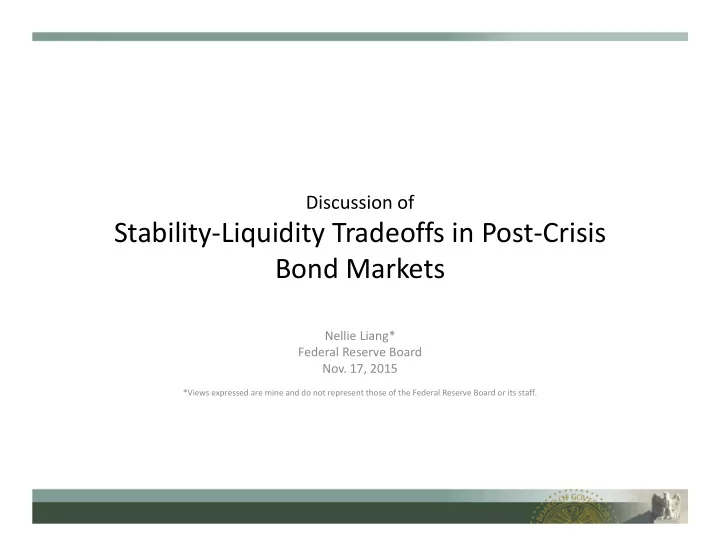

Discussion of Stability ‐ Liquidity Tradeoffs in Post ‐ Crisis Bond Markets Nellie Liang* Federal Reserve Board Nov. 17, 2015 *Views expressed are mine and do not represent those of the Federal Reserve Board or its staff.
Risks to market liquidity • Agree ‐‐ Changes are occurring and net effects on market liquidity are still playing out • Changes at dealers and asset managers – Structural changes in fixed ‐ income markets have reduced dealers’ information advantages – TRACE in corporate bonds (since 2002) and growth of proprietary automated trading – Since the crisis: Dealer market ‐ making reduced because of own risk management practices, new regulations, and low expected returns – Since the crisis: Increased risk of spike in demand for market liquidity if there are large redemptions from MFs with less ‐ liquid assets
Credit intermediation more resilient 3
Runnable liabilities are lower Includes uninsured deposits, repo, sec lending, MMFs, commercial paper, VRDOs, etc. See Bao, David, and Han (2015) 4
Dealer positions: A measure of willingness to provide market liquidity?
Market Liquidity: Corporate bonds
High ‐ yield bond funds: Increased risk of liquidity demand for large redemptions
Fund liquidity mismatch and first ‐ mover advantage • Fundamental mismatch – on ‐ demand redemption while investing in less liquid assets • First ‐ mover advantage ‐ funds mutualize costs of asset liquidations and costs borne largely by remaining investors • Creates investor incentive to redeem ahead of other investors • Could amplify redemptions and lead to greater asset sales than would occur if investors held assets directly • Mix of MFs and reduced liquidity could amplify credit cycle Severity would depend on sensitivity of redemptions and • potential for fire sales 8
Regulatory reforms for fund liquidity risk • SEC proposal (Sep 2015) proposal for liquidity risk management: • Assets reported by liquidity buckets and quarterly disclosure • Maintain a three ‐ day liquid asset minimum ‐ a minimum fraction of assets that can be converted to cash in 3 days without significant price impact • Board oversight of funds’ liquidity risk management programs • Disclosure of liquidity risk management practices (lines of credit, etc) • Also, option for swing pricing ‐ MFs can adjust NAVs based on the size and direction of net flows to incorporate liquidity costs
Asset management activities • MF intermediation has gotten more complex – more illiquid assets and leverage (derivatives, sec lending) • Proposals on stress testing and leverage expected from the SEC • FSOC is reviewing potential systemic risks
END 11
Credit ‐ to ‐ GDP gap, bank and nonbank Credit ‐ to ‐ GDP Ratio Gap (Final Estimate) 25 20 15 10 5 0 ‐ 5 ‐ 10 ‐ 15 ‐ 20 1980Q1 1991Q1 2002Q1 2013Q1 gap_bank gap_icpfmf gap_gse gap_oth
Example – Credit Default Swaps CDS notional amount of protection, 2013 2013 Bought ($B) Sold ($B) Dealers 12,834 12,943 Bank (non ‐ dealer) 206 221 Hedge funds 353 223 Asset managers 211 200 Ins, PFs, other 75 93 CCPs 1,378 1,378 Total 15,058 15,058 CDS contracts through DTCC in which one of the counterparties or the CDS contracts through DTCC in 2010. Non ‐ dealers include banks, reference entity is an institution regulated by the Federal Reserve. hedge funds, asset managers, insurers, pension funds, other. See See Campbell and Gallin, 2014, “Risk Transfer Using Credit Default Brunetti and Gordy, 2012, “Monitoring Counterparty Credit Risk and Swaps,” FEDS Notes. Interconnectedness in CDS.” FEDS working paper.
Recommend
More recommend